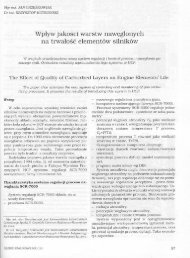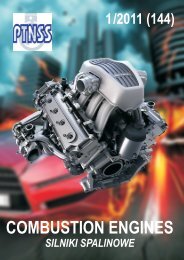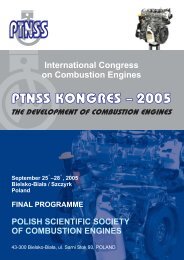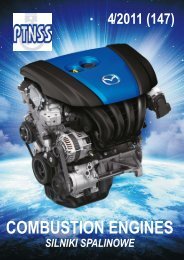Create successful ePaper yourself
Turn your PDF publications into a flip-book with our unique Google optimized e-Paper software.
Model research of injection of gasoline and E85 into the engine intake pipe<br />
intake pipe. It has been observed that the greatest differences<br />
in the fuel film thickness between Pb95 and E85 biofuel are<br />
observed within the range of small engine loads. kg coefficient<br />
expresses a relative increase of the mass of the E85<br />
fuel film as compared to gasoline.<br />
Following the injection of gasoline for a given engine<br />
speed, the fuel film thickness increased with an increase of<br />
the pressure in the intake pipe. When using ethanol, this<br />
trend was contrary and the film thickness decreased with an<br />
increase of the pressure. Figure 11 presents characteristics<br />
of kg coefficient of proportionality of the fuel film thickness<br />
in the intake pipe.<br />
6. Conclusions<br />
The obtained simulation test results allowed extending<br />
the knowledge on the processes of fuel-air mixture formation<br />
taking place when feeding gasoline and a mixture of<br />
gasoline and E85 ethanol to a spark ignition engine. It has<br />
been proved that the engine speed and the pressure in the<br />
intake system have effects upon the intensity of formation<br />
and the thickness of the fuel film following a replacement of<br />
gasoline with ethanol. The fuel film thickness for E85 is at<br />
times several times greater than that of gasoline. The reasons<br />
for the significant influence of both the tested factors include<br />
changed time courses of such phenomena as development<br />
and raising of the injected fuel spray by the flowing air and<br />
sedimentation of fuel on the intake pipe walls and, in particular,<br />
changes in the area and thickness of the fuel film.<br />
The obtained simulation test results indicate a usefulness<br />
of the testing method used for the analysis of the phenomena<br />
occurring in the engine intake system following the injection<br />
of fuel without interference with the system. The said results<br />
also reduce the testing time considerably.<br />
ka proporcjonalności grubości filmu paliwowego k g<br />
w przewodzie dolotowym.<br />
6. Podsumowanie<br />
Otrzymane wyniki z badań symulacyjnych pozwoliły<br />
rozszerzyć wiedzę o procesach tworzenia mieszanki<br />
paliwowo-powietrznej, zachodzących podczas zasilania<br />
silnika o zapłonie iskrowym benzyną oraz mieszanką<br />
benzyny i alkoholu etylowego E85. Wykazano, że<br />
istnieje wpływ prędkości obrotowej wału korbowego<br />
silnika i ciśnienia w układzie dolotowym na intensywność<br />
powstawania i grubość filmu paliwowego po<br />
zastąpieniu benzyny alkoholem etylowym. Grubość<br />
filmu paliwowego dla paliwa E85 przyjmuje niekiedy<br />
nawet kilkukrotną wartość grubości filmu paliwowego<br />
dla benzyny. Przyczynami istotnego wpływu obu czynników<br />
badawczych są zmienione czasowe przebiegi<br />
takich zjawisk, jak: rozwój i unoszenie strugi wtryskiwanego<br />
paliwa przez przepływające powietrze oraz<br />
osiadanie paliwa na ściankach przewodu dolotowego,<br />
a zwłaszcza zmian pola powierzchni i grubości filmu<br />
Fig. 11. Characteristics of k g<br />
coefficient of proportionality of the fuel film<br />
thickness<br />
paliwowego.<br />
Rys. 11. Charakterystyka współczynnika proporcjonalności grubości filmu k Uzyskane wyniki z badań symulacyjnych wskazują<br />
g<br />
na przydatność zastosowanej metody badawczej do<br />
analiz zjawisk, jakie zachodzą w układzie dolotowym<br />
silnika po wtrysku paliwa bez ingerencji w układ i znacząco<br />
skracają czas badań.<br />
Paper reviewed/Artykuł recenzowany<br />
Bibliography/Literatura<br />
[1] AVL FIRE, Methodology.<br />
[2] Guzzella L., Onder C. H.: Introduction to Modeling and Control<br />
of Internal Combustion Engine Systems. Springer-Verlag Berlin<br />
Heidelberg 2010.<br />
[3] Locatelli M.: Modeling and Compensation of the Fuel Path<br />
Dynamics of a Spark Ignited Engine. Doctoral Thesis, Swiss<br />
Federal Institute of Technology, Zurich 2004.<br />
[4] Stiesch G.: Modeling Engine Spray and Combustion Processes.<br />
Springer-Verlag Berlin, Heidelberg 2003.<br />
Marcin Szlachetka, MSc., MEng. – postgraduate in<br />
the Faculty of Mechanical Engineering at the Lublin<br />
University of Technology.<br />
Mgr inż. Marcin Szlachetka – doktorant na Wydziale<br />
Mechanicznym Politechniki Lubelskiej.<br />
e-mail: m.szlachetka@pollub.pl<br />
Prof. Mirosław Wendeker, DSc., DEng. – professor<br />
in the Faculty of Mechanical Engineering at Lublin<br />
University of Technology.<br />
Prof. dr hab. inż. Mirosław Wendeker – profesor na<br />
Wydziale Mechanicznym Politechniki Lubelskiej.<br />
e-mail: m.wendeker@pollub.pl<br />
<strong>COMBUSTION</strong> <strong>ENGINES</strong>, No. 4/2012 (151)<br />
63












